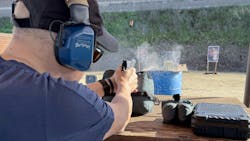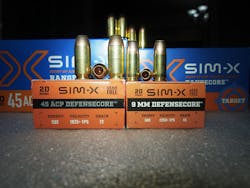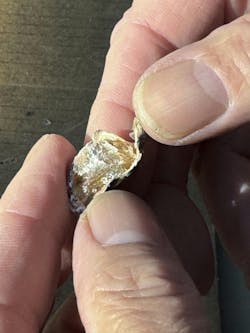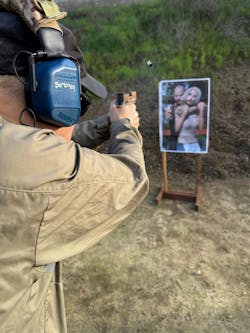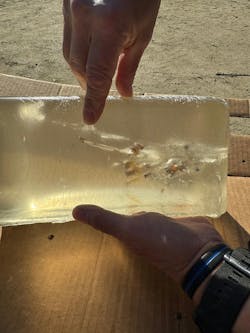Tested Lead-Free Duty and Training Ammunition Full of Good Surprises
What to know about the testing
-
SIM-X DEFENSECORE and RANGECORE cartridges use SUBMASS technology with synthetic, non-Newtonian polymer cores and precision alloy jackets, offering a completely lead-free, indoor-safe solution without hazmat cleanup requirements.
-
The 9mm DEFENSECORE round (45 grain) achieves velocities over 2100 fps with significantly reduced felt recoil, enabling faster, more accurate follow-up shots—ideal for both duty and competitive shooting applications.
-
Despite sub-FBI-standard penetration (3.5–6.75 inches), the rounds consistently expanded across barriers. RANGECORE training rounds closely mimic DEFENSECORE performance, supporting realistic, cost-effective training.
I tested the new cartridges from SIM-X, which are lead free, hyper lightweight bullets, driven to unusually high velocities. I tested their 45 ACP and 9mm designs. I found these designs were full of surprises, and all the surprises were good.
SIM-X is lead free ammunition. Rather than filling the core of the bullet with lead, the SIM-X DEFENSECORE bullet uses SUBMASS technology, which includes synthetic polymer core. The precision alloy jacket is a hard material, consistent with the appearance of copper. SIM-X cores are made of an epoxy-like material that behaves like a non-Newtonian fluid. The material is soft, and almost sticky in consistency.
This ammunition is completely lead free. It is indoor training safe. It does not require lead reclamation services to clean the range from hazmat.
SIM-X claims the non-Newtonian fluid design allows the bullet to achieve a better gas seal while traveling down the bore. A non-Newtonian fluid, by definition, has different viscosities, depending on the type of stress placed on it. Generally, non-Newtonian fluids behave like solids when they are placed under rapid stress. That is, when you punch a non-Newtonian fluid, it feels like a solid. If you compress it slowly, it behaves like a liquid.
When I examined the material inside the bullet, I noticed it was sticky, similar in consistency of dried tree sap. It was shaped into a deep hollow point within the recesses of the copper-like jacket.
Without a high-speed camera, or sensitive measuring equipment, both of which I do not own, it is hard to confirm the non-Newtonian fluid condition. It had consistent recoil and velocity and operated our test guns reliably. However, what I found out later really suggests that this emerging technology has value in the world of firearm defense.
There is a trend in defensive bullet technology toward lighter bullets with higher velocities. The science makes sense. To deliver the same energy to the target, a lighter bullet would have to travel at a much higher velocity. The design of the bullet would need to “dump” that energy into tissue quickly, to produce the desired tissue disruption. If all other things are equal, a lighter bullet will produce lighter recoil. Moreover, lighter bullets mean lighter things to carry on the body.
The 9mm SIM-X DEFENSECORE cartridges use 45 grain SIM-X bullets, which are less than half the weight of traditional defensive bullets. A magazine full of 9mm SIM-X DEFENSECORE magazine compared to standard cartridges is immediately evident.
Based on their advertised velocities, not only were the 9mm SIM-X cartridges less than half the weight of my 124 grain EDC rounds, but the numbers predicted that they would produce half their recoil as well.
We can estimate the amount of recoil from a cartridge using the principles of conservation of momentum. This is based on the velocity, weight of the firearm and bullet. We can’t do a full calculation, because it requires the weight of the propellant gases, but we can get a good prediction of the relative recoil of the cartridge.
What I have found from testing cartridges is the usefulness of "felt recoil". That is, compared to other cartridges, how did the act of firing this cartridge will different than others? If the "feel" of the recoil impulse is lighter than conventional rounds, it is a safe assumption that the shooter can fire more rounds within a given time.
One of the things that I discovered was how the light recoil impulse allowed me to come back on target quickly, firing fast accurate shots while moving. The phenomenon is so dramatic that most shooters do not realize how quickly they are shooting.
There is a game that competitive shooters have played for many years. They design cartridges that are as light as possible, to shoot as quickly as possible. The organizations that create the rules require a certain measurement, or a calculation of foot-pounds for a cartridge to be acceptable for competition.
When SIM-X sent their 9mm cartridges, they were accompanied by the SIM-X 9mm RANGECORE training rounds. The RANGECORE rounds were designed to duplicate the performance of the duty rounds yet be less expensive to use for practice.
RANGECORE cartridges utilize the same SUBMASS technology, only with a full metal jacket and a leadfree synthetic core. They do not utilize a non-Newtonian fluid for the core, but they are designed to complement the performance of the DEFENSECORE cartridges.
One of the more important aspects we have to measure is whether the training ammunition impacts the target in the same manner as the duty ammunition. If it hits differently, it has a reduced training value.
RANGECORE had the same characteristics as the DEFENSECORE, except they lacked a hollow point. I shot the RANGECORE rounds at various distances, and they correctly mimicked the DEFENSECORE ones. These 50 grain cartridges screamed out of my barrel at 2000 ft./s.
While I am writing this, it just occurred to me: I should have shot the SIM-X 9mm RANGECORE into ballistic gelatin, just to see what it would do. I was happy at how smoothly it ran in my SIG.
SIM-X publishes the 9mm DEFENSECORE velocity at 2250+ fps. I tested this cartridge in my SIG M18, which has a 3.9” barrel. I was using a Garmin Xero C1 Pro Chronograph, which conveniently does all my calculations for me. The 45 grain bullets averaged 2149.6 fps. This is not quite 2250 fps, but I was using a duty pistol, not a test barrel.
The calculated energy for this test session was 455 fpe (foot pounds of energy). A foot pound is the amount of kinetic energy it takes to move an object that weights a pound one foot. Most duty ammunition runs from 300–400-foot pounds for projectiles weighing 115-130 grains.
I fired the 45 grain bullets through bare ballistic gelatin, gelatin covered with heavy clothing, and through a windshield glass in front of gelatin. In all three media, the bullet opened in a different manner than most hollow points. It mushroomed, but since there are no pre-scored petals, the jacket did not peel away like most bullets. Instead, it flattened almost into a disc. in several iterations, the mouth part of the bullet expanded enough to tear the jacket. It retained the weight, but it appeared to explode in the ballistic gelatin. This performance was consistent, regardless of the barrier.
I began to measure from the beginning of the block to where the bullets settled. They averaged only about 3.5 to 4.5 inches. In the heavy clothing tests, the average was about 6.75 inches.
Anyone who has been paying attention to our bullet tests over the years would recognize that this performance is short of the FBI standard of 12 inches to 18 inches of penetration. However, one of the criteria of the FBI standards is to have a median performance that is within a certain range for barrier and non-barrier tests. At this point, at least I could say that the 45 brain 9 mm bullets came to rest in the general vicinity, regardless of what I shot it through.
I began to notice an unusual pattern, however. In most of the tests, there were one or two long striations that emanated from the point of rest of the bullet further into the block. None of these striations went to the edge of the block. The striations were consistent with the original direction of travel of the bullet. Several times I dug through the wound channel to see if a fragment of the jacket had broken off and traveled further. I couldn't find a thing.
In every bullet test, there is always some cavitation within the track of the bullet, that continues a bit further than its point of rest. One prevailing theory surrounding this was that the bullet created hydraulic pressure in front of its path that violently pushed aside tissue as it traveled. Scientists theorize that part of the effect of the path of the bullet was temporary cavitation, where tissue was stretched and displaced.
I didn't figure that's what was happening here. Several of the thin channels created were almost 10 inches long, past the resting point of the bullet. I can only conclude that these striations were created by solid material that was no longer solid, the very definition of a non-Newtonian fluid.
Is this what created them? Who knows. It’s going to require a someone smarter than me to understand this. If it is, this bullet design is so unique, it’s going to take better equipment to test it. If this was material expelled from the bullet however, it met the minimum FBI penetration standard.
There is one thing that can be said for this cartridge.
At the conclusion of the 9 mm portion of the test, the astronomically high energy that the speeding bullet was carrying is transferred very quickly into the ballistic gelatin. The trauma affect in living tissue would be dramatic.
I used my Armscor Rock Ultra to test the CCO SIM-X 45 ACP DEFENSECORE bullet. In the world of single action 45 this one is lightweight. I generally run 200 grain or lighter rounds in it to get rapid follow up shots. The 45 ACP DEFENSECORE bullets are 72 grains and are designed to run 1825+ fps.
I found similar results with the 45. The RANGECORE cartridges reliably imitated the DEFENSECORE ones. The 72 grain DEFENSECORE bullets averaged 1634.8 ft./s. out of the 4.25” barrel. Several of the bullets went 10 inches after striking glass, and some of them actually left the 16” test block after being fired through heavy clothing. Their accuracy was outstanding. I could easily shoot a group smaller than 4 inches standing unsupported at 20 yards. The supported groups were significantly better. This cartridge shot better than the ones I use for training in my 45.
SIM-X DEFENSECORE cartridges proved to be the most intriguing products on the market today. They have extremely low mass, which translates to lightweight on the belt. They travel at hyper velocities, and produce extremely low recoil. Their reliability, accuracy, and consistent performance can't be ignored. To be honest, I'm not really sure what to make of them.
About the Author

Officer Lindsey Bertomen (ret.), Contributing Editor
Lindsey Bertomen is a retired police officer and retired military small arms trainer. He teaches criminal justice at Hartnell College in Salinas, California, where serves as a POST administrator and firearms instructor. He also teaches civilian firearms classes, enjoys fly fishing, martial arts, and mountain biking. His articles have appeared in print and online for over two decades.
